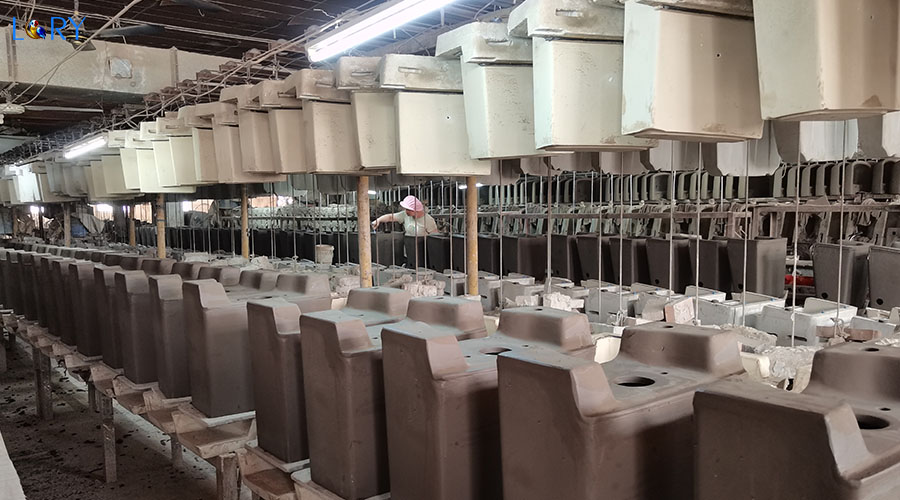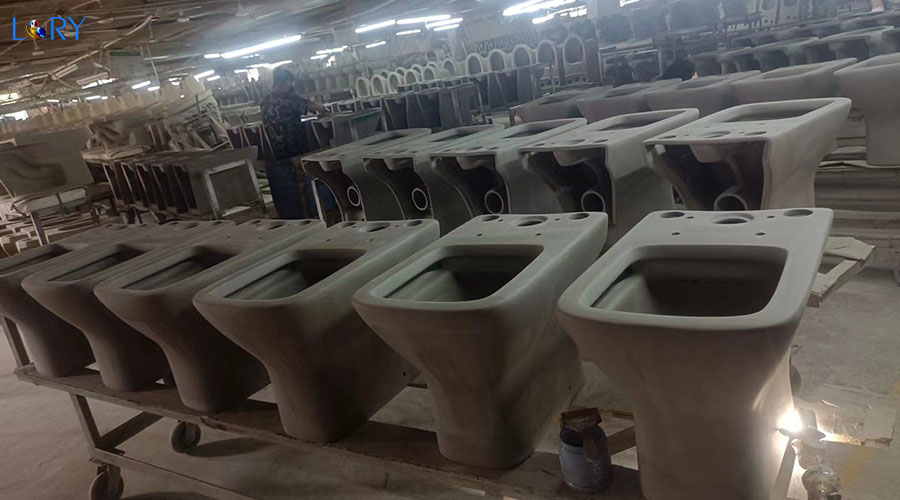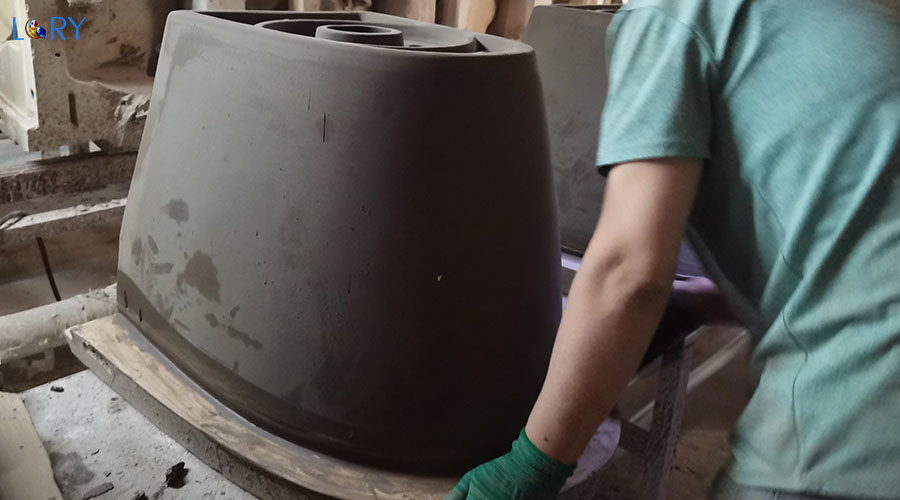
Section 1:Sanitary ware ceramics grouting method:
1.Hollow grouting (single-sided grouting)
The plaster molds used in this method have no cores. During operation, after a certain period of time after the mud is filled with the model, the inner wall of the model adheres to a green body with a certain thickness. Then the excess mud is poured out, and the shape of the green body is fixed in the model. This method is suitable for casting small and thin-walled products, such as ceramic crucibles, vases, pipe fittings, cups, pots, etc. The density of mud used for hollow grouting is small, generally 1.65-1.8g/cm3, otherwise there will be mud wisps and roughness on the surface of the green body after pouring.
Other parameters are as follows: Fluidity is generally 10-15 seconds and the thickening degree should not be too large (1.1-1.4). The fineness is generally finer than that of double-sided grouting, and the remaining 0.5%–1% is sieved by the 10,000-hole sieve.
2. Solid grouting (double-sided grouting)
Solid grouting is to inject mud into the cavity between two gypsum mold surfaces (model and mold core). The mud is absorbed by both sides of the working surface of the model and mold core. Since the moisture in the mud is continuously decreasing, grouting must be done successively. Supplement the mud until all the mud in the hole turns into blanks. Obviously, the thickness and shape of the green body are determined by the shape and size of the cavity between the model and the core, so no excess mud is poured out.
It can manufacture products with patterns on both sides and products with large size and complex shape: such as cups, fish plates, porcelain plates, etc. For solid grouting, thicker mud is often used, and the density is generally above 1.8g/cm3, so as to shorten the slurry suction time. Thickening degree (1.5-2.2), the fineness can be coarser, and the remaining 1%–2% is sieved by the million-hole sieve.
3. Enhanced grouting method
In order to shorten the grouting time and improve the quality of the grouting parts, some new grouting methods have been formed on the basis of the two basic grouting methods, which are collectively called enhanced grouting. There are mainly the following types of reinforced grouting:
(1) Pressure grouting
The method of increasing the mud pressure is used to accelerate the water diffusion, thereby accelerating the slurry suction speed. The simplest method of pressure grouting is to raise the position of the slurry tank, use the gravity of the slurry itself to feed the slurry from the bottom of the model, or use compressed air to inject the slurry into the model. According to the mud pressure, pressure grouting can be divided into micro-pressure grouting, medium-pressure grouting and high-pressure grouting. The grouting pressure of micro-pressure grouting is generally below 0.05MPa; the pressure of medium-pressure grouting is 0.15-0.20MPa; the pressure greater than 0.20MPa can be called high-pressure grouting, and high-strength resin molds must be used at this time.
(2) Vacuum grouting
Use special equipment to vacuum the outside of the gypsum, or place the reinforced plaster mold in a vacuum chamber for negative pressure operation, which can accelerate the formation of the green body and improve the density and strength of the green body.
(3) centrifugal grouting
Centrifugal grouting is to grout the model while it is rotating, and the mud is subjected to the action of centrifugal force to form a dense green body close to the model. Because the air bubbles in the mud are relatively light, when the model rotates, they are mostly concentrated in the middle and finally burst and discharged. It can also improve the suction speed and the quality of the product. However, the size of the solid particles in the mud used in this method should not be too large, otherwise the coarse particles will concentrate on the surface of the green body, and the fine particles will easily concentrate inside the mold, resulting in uneven structure of the green body and easy deformation due to drying shrinkage.
(4) Hot grouting
Hot slurry grouting is to install electrodes at both ends of the model. When the mud is full, connect the alternating current and use the electrolysis in the mud to
The conductivity of the material heats the mud and raises the temperature of the mud to about 50°C, which can reduce the viscosity of the mud and speed up the suction speed.
Section 2:Performance requirements of plaster mold and mud for grouting
The key to grouting molding is high-quality model and grouting mud with good performance.
1.Requirements for plaster models
(1) The model design is reasonable and easy to demould. The water absorption of each part is uniform, which can ensure that the drying shrinkage of each part of the green body is consistent, that is, the density of the green body is consistent.
(2) The model has small pores and good water absorption. Its porosity is required to be 30%-40%. When using it, the plaster mold should not be too dry. The water content is generally controlled at 4%-6%. If it is too dry, it will cause damage to the product. Defects such as cracks, air bubbles, pinholes, etc., and the service life of the mold is shortened, and excessive humidity will prolong the forming time and even make it difficult to form.
(3) The working surface of the model should be smooth and clean, without voids, oil stains or soap films.
2. Requirements for mud
(1) The fluidity of the mud is good, that is, the viscosity of the mud is small, which can ensure the flow of the mud in the pipeline and fully pour it into various parts of the model during use. A good slurry should flow out in a continuous thin line like cheese, otherwise it will be difficult to pour. If the model is complex, there will be defects such as insufficient fluid flow and missing corners.
(2) The water content should be as low as possible. On the premise of ensuring fluidity, reduce the water content of the mud as much as possible, which can reduce the grouting time, increase the strength of the green body, reduce drying shrinkage, shorten the production cycle, and prolong the use of plaster molds life. Generally, the water content of the mud is controlled at 30%-35%, and the density is 1.65-l.9g/cm.
(3) The stability is good, no components (such as quartz, feldspar, etc.) will be precipitated in the mud, and the composition of each part of the mud can be kept consistent for a long time, so that the structure of the injected part is uniform.
(4) Filterability (permeability) is better. That is to say, the moisture in the mud can pass smoothly through the mud layer attached to the model wall and be absorbed by the model. The filterability can be adjusted by adjusting the contents of barren and plastic materials in the mud.
(5) It has appropriate thixotropy. After a certain period of storage, the viscosity of the slurry should not change too much, so that the slurry is easy to transport and store, and at the same time, it is required that the green body after demoulding will not be soft and collapsed due to slight vibration. It is inconvenient to pour, and if the thixotropy is too small, the green body is easy to collapse, so proper thixotropy is required.
(6) The air content in the mud is as small as possible. A certain amount of air is usually mixed in the grouting material, so that there are a certain number of pores in the injection part. This phenomenon is more obvious for thicker mud. In order to avoid air bubbles And to improve the fluidity of the mud, vacuum defoaming treatment is often used in production.
(7) The formed body should have sufficient strength.
(8) After grouting, the green body is easy to demould.
Section 3:Types and selection of diluents
Generally speaking, the lower the water content of the mud, the worse the fluidity, and the grouting process requires the water content of the mud to be as low as possible and the fluidity to be good enough, that is, it is necessary to prepare thick mud with sufficient fluidity. In production, in order to obtain this Thick mud with as low water content as possible and good fluidity is to add diluent.
Diluents commonly used in ceramic industry production are divided into three categories:
1. Inorganic electrolyte.
Such as water glass, sodium carbonate, sodium phosphate, sodium hexametaphosphate, etc. This is the most commonly used class of diluents. To obtain the mud with the required viscosity, it is closely related to the type and quantity of the electrolyte that needs to be added and the type of clay in the mud. Generally speaking, the amount of electrolyte used is 0.3%-0.5% of the mass of the dry billet.
Water glass has the best effect on enhancing the suspending ability of kaolin mud. It not only significantly reduces its viscosity, but also has a very low viscosity in a wide range of electrolyte concentrations, which is beneficial to production operations. For the purple wood knot soil mud containing organic matter, the dilution effect of sodium carbonate is better than that of water glass.
In production, water glass and soda ash are often used as diluents at the same time to adjust the slurry suction speed and the softness and hardness of the green body. Because when water glass is used alone, the green body will harden quickly after demoulding, the difference between internal and external moisture is small, dense and hard, and easy to crack. When soda ash (Na2CO3) is used alone, the green body hardens slowly after demolding, the moisture difference between the inside and the outside is large, and the green body is soft, or hard on the outside and soft on the inside. When using electrolyte, pay attention to its quality. Soda ash turns into sodium bicarbonate when it gets wet, which flocculates the mud. Water glass (Na2SiO3) is a soluble silicate composed of alkali metal oxides (usually Na2O) and silicon dioxide in varying proportions. Its composition is represented by the molar ratio of SiO2/Na2O (called the modulus of water glass). When the modulus is greater than 4, colloidal SiO2 will be precipitated after long-term storage. The modulus of water glass commonly used as diluent is generally about 3.
2. Organic acid salts.
Such as sodium humate, sodium tannate, sodium citrate, rosin soap, etc. This type of organic substance has several conditions to be used as a diluent. They dilute better. The dosage of sodium humate is generally <0.25%. If it exceeds, the mud viscosity will increase again, which is similar to the dilution rule of inorganic electrolyte. In addition, if the amount is too large, if the organic matter is not burned out during firing, it will also make the glaze dark. The dosage of sodium tannate is generally about 0.3%-0.6%.
3. polyelectrolyte.
The history of using this type of diluent in the ceramic industry is much shorter than the above two types of diluents. Polyelectrolytes are often used as diluents for slurries that do not contain clay raw materials. Commonly used organic colloids are gum arabic, peach gum, gelatin, carboxymethyl cellulose sodium salt, etc. When the amount is small, the slurry will coagulate, and when it is increased appropriately, the slurry will be diluted. The amount is generally about 0.3%.
Section 4:Grouting molding operation process
The grouting molding operation process generally needs to go through the following procedures according to the product type and mud properties:
The main process is explained as follows:
(1) Mold closing
Before closing the mold, the working surface of the model should be cleaned, and no dry mud or dust should be left. And check whether the working surface of the mold is smooth, with or without voids and lubricating oil stains. If it is normal, the mold can be closed. If there is a large gap in the assembled model, use soft mud to block the gap at the joint to avoid slurry leakage. The model should not be too dry or too wet during use, and the water content is generally controlled at 4%-6%.
(2) Grouting
For single-sided grouting, it is enough to fill the model with the slurry. When the mud layer thickens to the required thickness, pour out the excess mud in the model. Uneven distribution. In production, it is necessary to shake the model with the blank after the mud is poured out to ensure that the residual mud is evenly distributed and avoid mud wisps.
For double-sided grouting, the mud must be replenished successively until all the mud in the cavity in the model becomes a green body. No need to pour and spin.
(3) green billet drying
The newly formed injection parts cannot be demolded immediately due to their high water content and low strength. They need to be dried with a mold for a certain period of time. This drying is called green blank drying. During the green blank drying, due to the evaporation of water and the continuous After absorbing water, the water content of the injected part will continue to drop, the green body will shrink and separate from the model, and the strength will gradually increase at the same time, and then it can be demolded.

(4) Demolding
After demoulding, the green body should be handled with care, laid flat, straightened, stabilized, and prevented from vibrating.

(5) Bonding
Bonding is a necessary process for making pots, cups, some small-mouthed vases, altars and other daily-use porcelains and art porcelains, sanitary porcelains, etc. that cannot be integrally formed. The formed parts are bonded together.